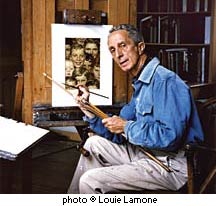Whether you’ve seen his covers for the Saturday Evening Post, his “Four Freedoms” World War II paintings, or been to the Norman Rockwell Museum in Stockbridge, Massachusetts, one thing is certain: Rockwell is one of the most iconic American painters of the 20th century.
Personal History
Born on February 3, 1894 in New York City, Rockwell knew from the age of 14 that he wanted to become an artist. He attended the Chase Art School at age 14, and later the National Academy of Design. He finally settled at the Art Students League in New York, where one of his major artistic influences, Howard Pyle, had attended.
Rockwell began his full-time career as an illustrator at the age of 17. Two years later, at the age of 19, he became the art director for Boy’s Life (the magazine for Boy Scouts of America) and had already illustrated his first book. At 22, he illustrated his first cover of the Saturday Evening Post.
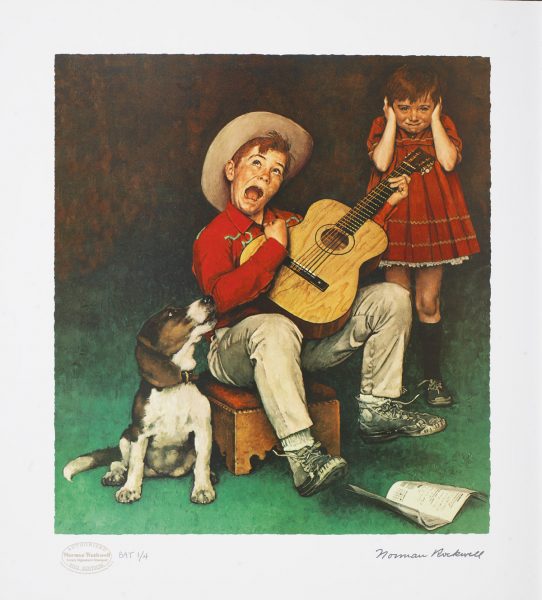
“The Music Lesson,” Norman Rockwell
In 1916, he married Irene O’Connor, who served as a model for Rockwell. They divorced in 1930, which caused Rockwell to move briefly to California, where he met Mary Barstow, a schoolteacher. The couple married that same year and would have three sons.
Rockwell attempted to enlist in the U.S. Navy during World War I, but was refused due to the weight requirements for someone of his height. Undeterred, Rockwell gorged on bananas and doughnuts in order to meet the weight requirement. He served as a military artist, but did not see any combat during his tour.
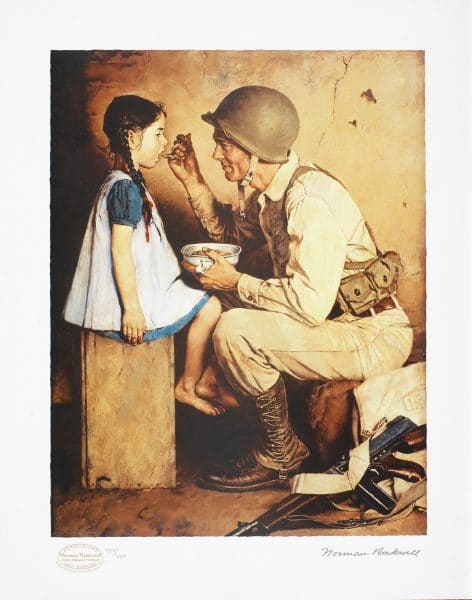
“The American Way” (Original image 1944; 2012), Norman Rockwell
Rockwell’s career with the Saturday Evening Post lasted for 47 years, totaling 322 original covers. With a captive audience of 3 million readers, the exposure Rockwell received was unprecedented, allowing for his illustrations to reach the hearts of the American people. Throughout his career alongside the Post, Rockwell covered a range of topics that playfully captured everything from heartwarming moments of the American family to inspirational scenes in American history.
Due to the popularity and exposure he received from working at the Post, Rockwell began creating covers for other magazines, including Literary Digest, the Country Gentleman, and Life magazine.
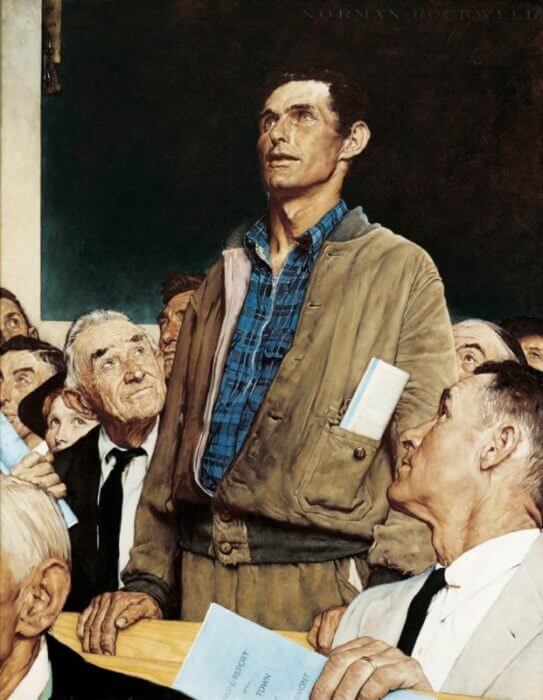
“Freedom Of Speech”
(1943), Norman Rockwell. From “The Four Freedoms”
In 1943, Rockwell painted his famous Four Freedoms suite, inspired by President Franklin D. Roosevelt’s 1941 speech of the same name. The four paintings, titled “Freedom of Speech,” “Freedom of Worship,” “Freedom from Want,” and “Freedom from Fear,” were so labor-intensive that Rockwell lost 10 pounds during the in seven months it took to create them. The images were published in the Saturday Evening Post in 1943. Inspired by the imagery, the U.S. Department of Treasury used the paintings as a promotion to sell war bonds and stamps, helping to raise more than $130 million in war bonds.
Sadly, in the same year he completed the Four Freedoms, a fire destroyed his studio in Arlington, Vermont, which housed several paintings and his collection of historical costumes and props. The Rockwell family moved to Stockbridge, Massachusetts in 1953. Tragedy struck once again when his wife died suddenly in 1959. He married Molly Punderson, a retired teacher, in 1961.
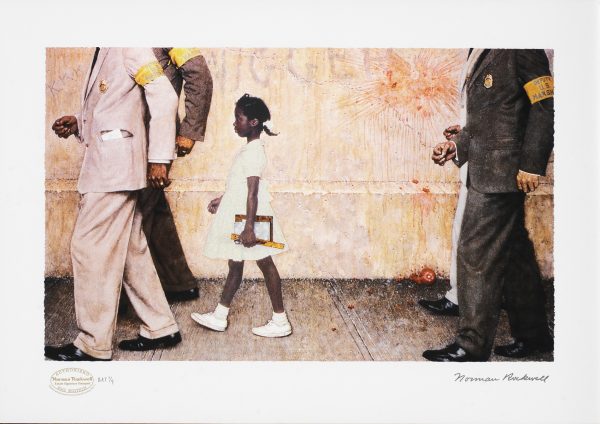
“The Problem We All Live With” (2012), Norman Rockwell
In 1963, Rockwell left the Post and began illustrating at Look magazine. Over the next 10 years while at Look, he painted controversial subjects like civil rights and poverty that he was otherwise prohibited from painting by the Post, bringing about some of his most famous works. For instance, his painting, “The Problem We All Live With,” shows a young African-American girl (Ruby Bridges) being escorted to school on the first day of New Orleans’ integration.
Rockwell began making lithographs with Circle Gallery, and by the third year, editions were selling out as quickly as they were published. Later he created works for other publishers and developed a large international market for his prints, paintings, drawings, and collectibles.
In 1973, Rockwell established a trust for his artwork with the Old Corner House Stockbridge Historical Society, which later became the Norman Rockwell Museum at Stockbridge. He soon after had his studio along with its contents added to the trust.
Rockwell died on November 8, 1978, at the age of 84 in his Stockbridge home.
Style and Influences
Rockwell created more than 4,000 original paintings during his career. Today, the phrase “like a Norman Rockwell painting” summarizes his far-reaching influence on portraying American culture.
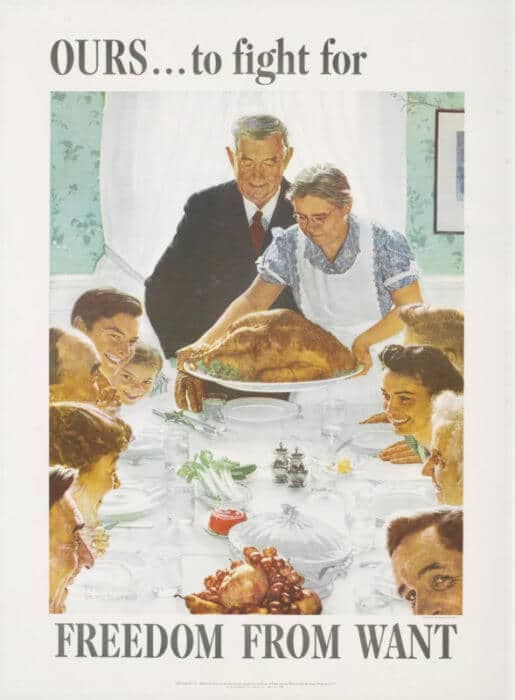
“Freedom From Want” (1943), Norman Rockwell.
From “The Four Freedoms.”
As a child, Rockwell’s father read the stories of Charles Dickens to him. He was enchanted by the descriptions Dickens gave, and often drew his characters as he imagined them. Rockwell’s more artistic influence stems from Howard Pyle, a respected American illustrator and artist. Rockwell’s teachers at the Art Students League often held up Pyle as a role model to emulate, furthering Rockwell’s reverence for the artist.
Rockwell considered himself a visual storyteller. His characters, which included elements of caricature, are authentic. Expressive, charming, and relatable, his characters encouraged viewers to see the best of themselves in his accessible art. Early in his career, Rockwell dedicated himself to painting characters that were relatable.
“Maybe as I grew up and found the world wasn’t the perfect place I had thought it to be, I unconsciously decided that if it wasn’t an ideal world, it should be, and so painted only the ideal aspects of it,” Rockwell once said.
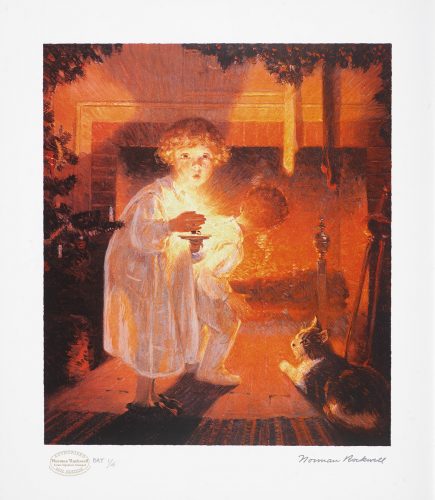
“Is He Coming?” Norman Rockwell
Rockwell was known for carefully observing the behaviors of the people around him to find inspiration for his paintings. He even invited strangers into his studio to pose as models for paintings. He sketched and photographed them in various poses, ultimately combining his studies into one of his compositions. It’s with this balance of optimism and observation that Rockwell was able to portray both humorous and powerful messages in his art.
Accomplishments
- Notable collectors of Rockwell’s art include film directors Steven Spielberg and George Lucas.
- 1943 – Rockwell’s Four Freedoms suite is exhibited in 16 U.S. cities by the Department of Treasury, helping raise $130 million in war bonds.
- 1966 – Rockwell paints portraits of the stars in the film “Stagecoach,” and is even included as an extra in the film.
- 1976 – The artist completes his final commission for the Boy Scouts, a calendar illustration.
- 1977 – President Gerald Ford presents Rockwell with the Presidential Medal of Freedom, the highest honor a civilian can receive in the United States.
- 2006 – The Rockwell painting “Breaking Home Ties” sells for $15 million, setting a new record for a Rockwell painting.
- 2008 – Rockwell is posthumously named the official artist of the Commonwealth of Massachusetts.
- 2013 – Rockwell’s “Saying Grace” sells for $46 million at auction (including a buyer’s premium), setting the new record.

